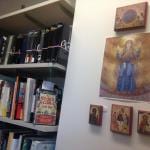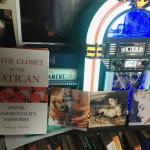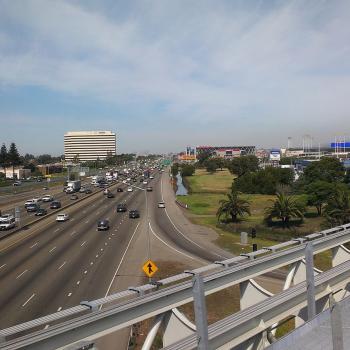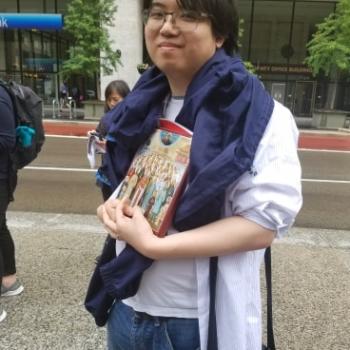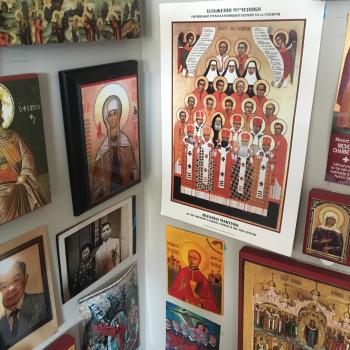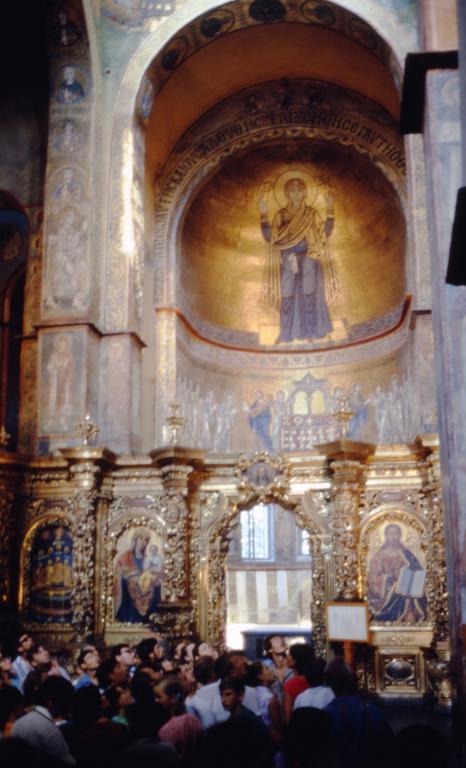
It has been of some surprise to me that my womanist convictions are being strengthened by this church. Womanism is the ontological claim that the constitution of the world, of things as the way they are, is somehow feminine and that therefore patriarchy is an ideology of colonizing violence. In the terms of Latin moral theology, womanism is not and cannot be gender theory; instead, it is the exposure of patriarchy as the original ideology of gender. Womanism is not ideological because it is not a proposal, in the strictest of senses, for an ideal paradise. Rather, it is the phenomenological claim that the feminine is constitutive of reality. There is, except in the case of that cadre of insecure men on the Internet who talk so much online about masculinity and theological orthodoxy to distract from the small problem that their insecurity precludes women (or men, for that matter) from being attracted to them, very little theological or philosophical controversy that can be generated from this claim. In fact, it is deeply biblical, with the curse attached to the woman in the garden about male domination, which means that that condition — which is further spelled out in the bumbling idiocy of patriarchs like Abraham, Isaac, Jacob, and Judah in Genesis — is not the way things were meant to be. Its poetry is also suffused throughout the tradition, beginning with the psalmists who discover themselves as weaned children beneath the wings of their mothers in the description of divine protection and nurture and tracking all the way to Dame Julian of Norwich’s visions of the bleeding Christ, which eventually turns into a reflection of this blood that he feeds us as indicative of his own role as Mother. Only those who think without prayer will be scandalized by such reflection; those who pray will recognize the familiar intimacy here that comes of tapping into the supernatural that is constitutive of reality itself.
Perhaps I am overly influenced by my brother Julian Hayda, but he has me convinced that Wisdom herself is an avatar of such womanism, especially in the Kyivan Church. As Hayda repeatedly points out to me, there is something significant that about Kyivan culture where all the figures that distinguish Kyiv from other Orthodox cultures — the goddess Berehynia whose wings are outstretched over the Maidan, the black earth from which the food that nourishes the people who eat it suggests that it must have a maternal quality, the matrilineal and matriarchal makeup of families in Kyivan Rus’ prior to the colonizations that introduced patriarchal ideology into familial practices — find their fulfillment in the great Cathedral of St Sophia that all the children of the Holy Equal-to-the-Apostles Volodymyr and Olha call their home, the place where Lady Wisdom has built her house and set its foundations, where the Oranta stands in the apse with her arms lifted in prayer as the Immovable Wall, by whose intercessions the city will never be taken. Wisdom, as the icon of Holy Sophia centers on a throne as she was there from the foundations of the world and is adored by prophets, apostles, and angles, is fundamentally woman in this tradition. In this reading, Hayda is not alone, of course; in Pray for God’s Wisdom, the founder of the Metropolitan Andrey Sheptytsky Institute, Fr Andriy Chirovsky, meditates on how Sheptytsky, as the primate of the Greek-Catholic Church of Kyiv for nearly the entire first half of the twentieth century, ordered that each temple should have an icon of Holy Sophia installed in its altar. So too, Patriarch Sviatoslav has recently issued a letter on the centrality of Holy Sophia in suffusing the Kyivan Church with a ‘sophianic’ culture, so much so that he has invited us to join him on a pilgrimage to St Sophia’s Cathedral for the Feast of the Annunciation this year because that place is the center of our spiritual heritage.
The temptation here is to entrench oneself in an obsession with Kyivan identity, to locate such impulses as the provenance of Ukraine, to engage in a kind of nationalism that insists that because what is being described here is distinctively Ukrainian that it has nothing to say to the rest of the world. But the Kyivan Church is a Catholic church; its Orthodoxy is universal, available to all who encounter it and indeed, as Bishop Benedict of Chicago has noted, open to a wide spectrum of influences that clarify its charism. Of course I am interested in the source of my tradition, which is certainly tied to Ukraine, but traditions are meant to be passed down, to be handed over, to be developed by those who are just as much agents of the divine as our mothers and fathers of old.
I think, then, of what it means for me to receive this tradition, and when I say me, I realize that I have written about myself as Chinese Christian and fallen complicit sometimes in the very same ethnophyletism that I want to avoid. I did grow up Chinese Christian, but the church is not the only institution that has shaped my life. I also went to school, among other places, and here in America, as a child of the nineties, there was no resisting even within the networks of conservatism the literary power of women of color. My first encounter with excerpts from Maya Angelou’s classic memoir I Know Why the Caged Bird Sings was in fourth grade, in a reading textbook that we used at the Pentecostal school. In Catholic school, I came to re-read Genesis and Ruth through Alice Walker’s Color Purple, and it affected me so much that when I led a series of Bible studies at our Cantonese Protestant church on the Book of Judges, I couldn’t help but notice that the further the people of God stray from the law, the more misogynistic they get and the more that the agency of women, who are leaders like Acsah, Deborah, and Jael at the beginning of the book, becomes horribly subjected to oppression, descending from Delilah to Jephthah’s daughter to the daughters of Shiloh kidnapped by the Benjamites for what can only be described as sexual slavery. The works of the Catholic writer Toni Morrison may have drawn the ire of right-wing concerned parent activists, but I still remember the raw power of Jazz, especially the ending where the book itself starts talking, celebrating an old married couple’s love in their everyday gestures. I cried when I read that, and have re-read it over and over, and made a promise to myself when I was seventeen that I would seek out that kind of marriage. It informs my practice as a flawed husband aspiring to perfection even now.
To claim that the Kyivan sophianic tradition is womanist is, I am reflecting, to force at least an encounter between the wisdom of such women-of-color writers in the Americas and our practices of prayer. Indeed, the intriguing trio known as the ‘new theologians of race’ — Willie Jennings, J. Kameron Carter, and Brian Bantum — have already suggested such a rapprochement as a way forward, especially because they read Ignatius of Antioch, Maximus the Confessor, and Gregory of Nyssa together with black, Latinx, and indigenous thinkers. Indeed, it was from a lecture given by Carter on some of his forthcoming work that I learned, as one late to class, of Sylvia Wynter. In the same way, I discovered from a syllabus in which the philosopher of education Sam Rocha introduced the concept of study to his students a book that I should have read long ago by bell hooks, Teaching to Transgress. Here, though, the question arises on what it would mean to take seriously the fact that among the most profound and life-giving writers I have read in the academy are womanists and women of color. In engaging them, do I not cross the gap from school to the church I have encountered as profoundly womanist? What would it mean, I have been asking myself as I have not only taught but prayed with Sylvia Chan-Malik’s Being Muslim: A Cultural History of Women of Color in American Islam, to read as a mystagogical practice the works of, say, Morrison, Angelou, Walker, Wynter, hooks, Audre Lorde, Octavia Butler, Michele Wallace, Katie Cannon, Delores Williams, and Andrea C. White? What might it look like as a Kyivan Christian to take seriously the women writers and performers who sing in poetry the joys and traumas of the arena of both professional work and personal life that circumscribes my field of action, the Pacific, such as in the works of Jinah Kim, Patricia Nguyen, mai c. doan, Soultree, Emily Jungmin Yoon, Franny Choi, and others I am reading and breathing in because I am discovering that we pray the same way? Would not such investments underscore the catholicity of the womanist sophiology highlighted in the long memory of Kyivan practice?
I offer two concrete examples from my life to illustrate what I have been learning. One is very recent and highlights the necessity of such womanist mystagogy for me as a man. Without divulging too much detail, a recent event at my university in which I had some part to play resulted in some resentment toward me by a dear colleague because I obliviously placed on her the burdens of preparing for the program without even knowing or caring to inquire what labour was involved. I had to be pulled aside by someone more senior, a woman-of-color scholar who has patiently educated me despite the habits of my miseducation, and informed that what I had done was terribly gendered, not least because I hadn’t the slightest clue what I had not done because it had always been done for me by invisible hands. Not only have I offered apologies and reparations — we are good now, I think — but it became a teaching moment for me in my classes about my own ongoing need for conscientization in this regard, and in this sense, I am glad that my educational experience within the space of the school is still marked by the wisdom of womanist scholars.
This example brings me to a second moment of learning, one that took place at the close of my catechumenate when my spiritual father and I were discerning whether I should actually enter the Kyivan Church. It dawned on us that among the many sins I had to repent of and work through in this church, around the top would be my propensity for putting words into my wife’s mouth and acting as if her views of the world didn’t matter. The condition that was then set on my reception was that she’d have to acquiesce to it, without me manipulating her, and that her yes had to be tested for its freedom. It was, as my spiritual father put it at the time, a kind of practice of the ‘preferential option for the poor’ — in this case, a radical repentance from my participation in alpha male theological circles that don’t think that anyone who can’t speak their language matters, which is terribly dangerous theologically, considering that the Lord exalts the humble and humbles the proud. The church, as I experienced it at that moment, demanded my repentance from the habits of misogyny. The womanist impulse, one might say, has been with me in my experience of Kyivan Christianity from the beginning. These reflections are perhaps a statement of intention that I will continue to explore in this mystagogical journey, especially as the Great Fast is quickly upon us, what this sophianic thread is.

